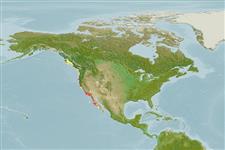>
Eupercaria/misc (Various families in series Eupercaria) >
Sciaenidae (Drums or croakers)
Etymology: Seriphus: Greek, seriphos, -ou, serphos = a mosquito or winged ant (Ref. 45335).
More on author: Ayres.
Environment: milieu / climate zone / depth range / distribution range
Ecologie
marien demersaal; diepte 1 - 21 m (Ref. 2850), usually 1 - 8 m (Ref. 2850). Subtropical; 54°N - 23°N, 133°W - 109°W
Eastern Pacific: Yaquina Bay in Oregon, USA to southern Baja California, Mexico. Recorded from British Columbia, Canada (Ref. 11980).
Lengte bij maturiteit / Grootte / Gewicht / Leeftijd
Maturity: Lm 10.3, range 10 - 10.5 cm
Max length : 30.0 cm TL mannelijk / geslacht onbekend; (Ref. 2850)
Occur inshore, often over sandy bottoms. Common in bays and tidal sloughs, around pilings. Moves to deeper water at night (Ref. 9118). Form schools. Feed on small shrimps, marine worms and fishes (Ref. 9118). Pelagic spawners (Ref. 56049).
Mean interval between spawnings is about 7.4 days (Refs. 51164, 51165).
Eschmeyer, W.N., E.S. Herald and H. Hammann, 1983. A field guide to Pacific coast fishes of North America. Boston (MA, USA): Houghton Mifflin Company. xii+336 p. (Ref. 2850)
Status op de Rode Lijst van het IUCN (Ref. 130435)
Gevaar voor de mens
Harmless
Gebruik door de mens
Visserij: van minder commercieel belang; aas: usually
Meer informatie
Leeftijd/GrootteGroeiLengte-gewichtLengte-lengteLengtefrequentiesMorfometrieMorfologieLarvenLarvale populatiedynamiekRekruteringAbundantieBRUVS
ReferentiesAquacultuurAquacultuurprofielKweeklijnenGeneticaElectrophoresesErfelijkheidZiektesVerwerkingNutrientsMassaconversie
Tools
Speciale rapporten
Download XML
Internetbronnen
Estimates based on models
Preferred temperature (Ref.
123201): 9.6 - 18.6, mean 11 °C (based on 159 cells).
Fylogenetische diversiteitsindex (Ref.
82804): PD
50 = 1.0000 [Uniqueness, from 0.5 = low to 2.0 = high].
Bayesian length-weight: a=0.00575 (0.00278 - 0.01190), b=3.11 (2.93 - 3.29), in cm total length, based on LWR estimates for this (Sub)family-body shape (Ref.
93245).
Trofisch niveau (Ref.
69278): 3.7 ±0.57 se; based on food items.
Generation time: 5.5 ( na - na) years. Estimated as median ln(3)/K based on 2
growth studies.
Weerstandsvermogen (Ref.
120179): Gemiddeld, minimale populatieverdubbelingstijd 1,4-4,4 jaar (tm=2; Annual fecundity = 300,000).
Fishing Vulnerability (Ref.
59153): Moderate vulnerability (39 of 100).
